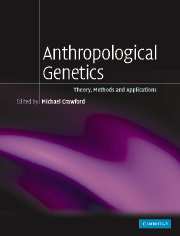Book contents
- Frontmatter
- Contents
- List of Contributors
- Preface
- Chapter 1 Foundations of Anthropological Genetics
- Part 1 Theory
- Part 2 Methods
- Part 3 General Applications
- Part 4 Part IV The Human Diaspora
- Chapter 12 Human Origins Within and Out of Africa
- Chapter 13 The Peopling of Europe
- Chapter 14 The Peopling of Oceania
- Chapter 15 The Prehistoric Colonization of the Americas
- Chapter 16 Anthropological Genetics: Present and Future
- Index
- References
Chapter 13 - The Peopling of Europe
Published online by Cambridge University Press: 05 June 2012
- Frontmatter
- Contents
- List of Contributors
- Preface
- Chapter 1 Foundations of Anthropological Genetics
- Part 1 Theory
- Part 2 Methods
- Part 3 General Applications
- Part 4 Part IV The Human Diaspora
- Chapter 12 Human Origins Within and Out of Africa
- Chapter 13 The Peopling of Europe
- Chapter 14 The Peopling of Oceania
- Chapter 15 The Prehistoric Colonization of the Americas
- Chapter 16 Anthropological Genetics: Present and Future
- Index
- References
Summary
Summary
Although hominins were present in Europe as early as ~780 thousand years ago, there is broad agreement that these archaic humans, including Neanderthals, contributed little to the contemporary European gene pool. In contrast, there is vigorous debate about the relative contributions of humans who entered in the Upper Paleolithic and Neolithic. Here, we argue that the Y-chromosomal diversity pattern is likely to have a largely Neolithic or later origin. In addition to the genome-wide influences resulting from migration, admixture and drift, the effects of positive selection are detectable around some genes, such as lactase. Studies of species associated with humans, e.g. cattle, are providing additional insights.
Why study Europe?
Introductory remarks: why Europe?
The western edge of the Asian continent has a special status in studies of history, prehistory, anthropology and many other fields, more because of the origin of the people conducting these studies than the properties of the area. It is conventionally considered as a continent in its own right, Europe, although the geographical justification for this is difficult to see and a clear definition of parts of its eastern boundary, such as between the Urals and Bosphorus, is not easy to establish. Furthermore, much of the terminology we use and attempt to apply to the rest of the world, ‘Stone Age’, ‘Bronze Age’, etc. derives from studies of Europe. Now that we can take a more global view of some of these matters, does Europe still provide a legitimate unit of enquiry?
- Type
- Chapter
- Information
- Anthropological GeneticsTheory, Methods and Applications, pp. 380 - 408Publisher: Cambridge University PressPrint publication year: 2006
References
- 1
- Cited by



